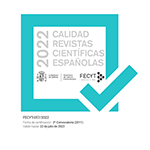Woody vegetation within semi-abandoned olive groves: species-area relationships and minimum area values
Abstract
The species-area relationship is among the most important patterns in ecology, and is an important tool in conservation. However, research into the species-area and minimum area dynamics of Mediterranean vegetation remains scarce, and this is particularly concerning since the heterogeneity of Mediterranean mosaic systems is being threatened by widespread land abandonment. This study investigates the woody vegetation at three semi-abandoned olive groves in the Sierra Morena de Córdoba, Southern Spain. We determined the mathematical nature of the species-area curves, and obtained minimum area values as a threshold patch size to target in terms of efficiently maximising species richness conservation. Power models proposed by Arrhenius could represent the species-area relationship of all three sites, yet Gleason’s exponential model performed better at one of the groves. Surrounding habitat quality and vegetation history impacted the nature of the species-area relationship, and this was reflected in significant differences among the minimum area values. This study provides one the first descriptions of woody plant communities at partially and intermittently managed groves in the Mediterranean region, and gives insight into the potential impacts of partial abandonment on landscape conservation. Enlarging patches up to the minimum area threshold could promote plant diversity whilst maintaining an open landscape, although researchers should give special care into adequately modelling the species-area relationship, in order to obtain appropriate minimum area values.
Downloads
Article download
License
Mediterranean Botany is an open access journal to promote global exchange knowledge. It facilitates unrestricted access to its contents from the moment of publication in its electronic edition. The originals published are property of the Universidad Complutense and it is mandatory to cite such source in case of total or partial reproduction. All contents are distributed under a Creative Commons License 4.0 (CC BY 4.0). This circumstance must be expressly stated in this way when necessary. You can check the informative version and legal text of the license.














